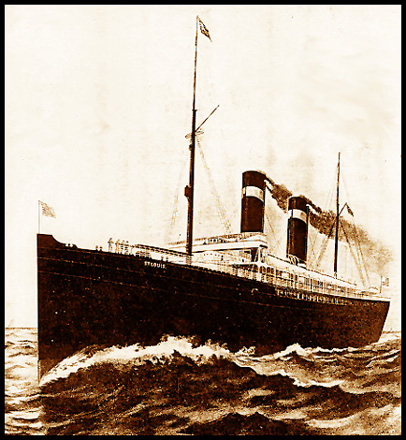


These ships were provided with seventeen watertight compartments, and additional compartments surrounding the machinery.
In 1891, Congress granted a subsidy to owners of privately owned vessels carrying U.S. Mail in an effort to create an "auxiliary navy". The act required that ship owners obtaining the subsidy make their vessels available to the navy in times of war. By 1896, twenty-nine vessels made up the "auxiliary navy". Of those vessels, ST. PAUL and St. LOUIS were the largest.
During the war, the ST. PAUL saw active duty in the waters around Cuba, capturing those vessels listed above. In addition to service off Cuba, the St. Paul operated off Puerto Rico, blockading the port of San Juan in late June, 1898. At 1:30 pm, June 22, 1898, the Spanish torpedo boat destroyer TERROR sortied from San Juan and attacked the St. Paul. The 370 ton vessel was severely damaged by the St. Paul's fire and had to be beached. The TERROR was repaired in San Juan and left for Spain on September 14, 1898, after the end of hostilities.
After the war, the ships reverted to ocean liners. In 1900 the ST. PAUL collided with a submerged wreck and lost it starboard propeller and destroyed the starboard engine. In 1908 it collided with the HMS GLADIATOR, killing twenty-seven.
In World War I, the ST. PAUL was outfitted as the troopship KNOXVILLE, but capsized in New York before the work was completed. She was returned to American Lines. She was repaired and used until being scrapped in 1923.
Lastly, since the vessels were put into service as auxiliary cruisers,
the crewmen were not previously familiar with the ships, nor had they previously
worked together as a unit. This cohesion and innate knowledge of a vessel
can be the most critical factors in the operation of a naval vessel. The
crews of the ST. PAUL and ST. LOUIS did not have the time to develop these
aspects of their training before being sent into action.
| Classification: | Auxiliary Cruiser | |
|---|---|---|
| Completed: | 1895 | |
| Navy Comissioning: | April 20, 1898 | |
| Rig: | Two masts, schooner rig. | |
| Armament: | Six 5 inch rapid fire guns | |
| Six 6-pounder guns | ||
| Six 3 pounder guns | ||
| Contractor: | William Cramp & Sons, Philadelphia, PA. | |
| Length: | 554 feet | |
| Beam: | 63 feet | |
| Mean draft: | 25 feet | |
| Displacement: | 14,910 tons | |
| Complement: | 24 officers and 357 men. | |
| Commanded by Capt. C. D. Sigsbee from May 5, 1898 until the end of the war. (Sigsbee was the commanding officer of the USS MAINE at the time of its loss.) | ||
| Engine type: | Quadruple expansion engines generating | |
| over 20,000 hp. Twin screw. | ||
| Speed: | 22 knots | |
| Coal bunker capacity: | 2677 tons |
Cox, Martin, Titanic Mailing List (Personal Internet Contact)
Jeffers, H. Paul, Colonel Roosevelt: Theodore Roosevelt Goes to War, 1897-1898. (New York: John Wiley & Sons, Inc., 1996).
Miller, William H., The First Great Ocean Liners in Photographs. . New York: Dover Publications, 1984.
Rivero, Captain Angel, Crónica de la Guerra Hispanoamericana en Puerto Rico, Editorial Edil, Inc., Rio Piedras, Puerto Rico, 1972 (reprint, first published 1921). Thanks to Ramiro Cruz.
The American Navy/Cuba and the Wrecked Maine/The Hawaiian Islands, (Chicago: George M. Hill Company, 1898).

